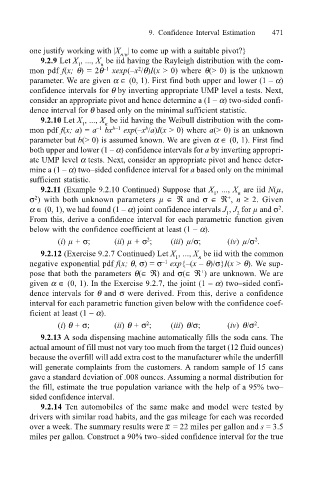Page 494 - Probability and Statistical Inference
P. 494
9. Confidence Interval Estimation 471
one justify working with |X | to come up with a suitable pivot?}
n:n
9.2.9 Let X , ..., X be iid having the Rayleigh distribution with the com-
n
1
mon pdf f(x; θ) = 2θ xexp(x /θ)I(x > 0) where θ(> 0) is the unknown
2
1
parameter. We are given α ∈ (0, 1). First find both upper and lower (1 α)
confidence intervals for θ by inverting appropriate UMP level a tests. Next,
consider an appropriate pivot and hence determine a (1 α) two-sided confi-
dence interval for θ based only on the minimal sufficient statistic.
9.2.10 Let X , ..., X be iid having the Weibull distribution with the com-
n
1
b
1
mon pdf f(x; a) = a bx exp(x /a)I(x > 0) where a(> 0) is an unknown
b1
parameter but b(> 0) is assumed known. We are given α ∈ (0, 1). First find
both upper and lower (1 α) confidence intervals for a by inverting appropri-
ate UMP level α tests. Next, consider an appropriate pivot and hence deter-
mine a (1 α) twosided confidence interval for a based only on the minimal
sufficient statistic.
9.2.11 (Example 9.2.10 Continued) Suppose that X , ..., X are iid N(µ,
n
1
+
2
σ ) with both unknown parameters µ ∈ ℜ and σ ∈ ℜ , n ≥ 2. Given
2
α ∈ (0, 1), we had found (1 α) joint confidence intervals J , J for µ and σ .
2
1
From this, derive a confidence interval for each parametric function given
below with the confidence coefficient at least (1 α).
2
(i) µ + σ; (ii) µ + σ ; (iii) µ/σ; (iv) µ/σ .
2
9.2.12 (Exercise 9.2.7 Continued) Let X , ..., X be iid with the common
n
1
negative exponential pdf f(x; θ, σ) = σ exp{(x θ)/σ}I(x > θ). We sup-
1
+
pose that both the parameters θ(∈ ℜ) and σ(∈ ℜ ) are unknown. We are
given α ∈ (0, 1). In the Exercise 9.2.7, the joint (1 α) twosided confi-
dence intervals for θ and σ were derived. From this, derive a confidence
interval for each parametric function given below with the confidence coef-
ficient at least (1 α).
(i) θ + σ; (ii) θ + σ ; (iii) θ/σ; (iv) θ/σ .
2
2
9.2.13 A soda dispensing machine automatically fills the soda cans. The
actual amount of fill must not vary too much from the target (12 fluid ounces)
because the overfill will add extra cost to the manufacturer while the underfill
will generate complaints from the customers. A random sample of 15 cans
gave a standard deviation of .008 ounces. Assuming a normal distribution for
the fill, estimate the true population variance with the help of a 95% two
sided confidence interval.
9.2.14 Ten automobiles of the same make and model were tested by
drivers with similar road habits, and the gas mileage for each was recorded
over a week. The summary results were = 22 miles per gallon and s = 3.5
miles per gallon. Construct a 90% twosided confidence interval for the true

